What is Holland’s oldest beer?
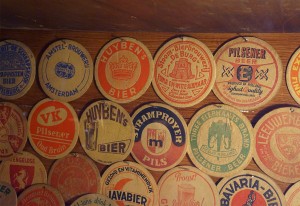 Sometimes a question pops up in your head which makes you think: why has no-one asked it before? Like: what is the oldest beer in The Netherlands still in existence? All this time I have been talking about ‘lost beers’, but what beers actually didn’t go lost? Beers where you can draw a straight line between their origin and today? The answer comes from 1872, and it is surprising, but also nicely appropriate for this time of the year…
Sometimes a question pops up in your head which makes you think: why has no-one asked it before? Like: what is the oldest beer in The Netherlands still in existence? All this time I have been talking about ‘lost beers’, but what beers actually didn’t go lost? Beers where you can draw a straight line between their origin and today? The answer comes from 1872, and it is surprising, but also nicely appropriate for this time of the year…
It is no unimportant question, when it comes to Dutch beer. At a Dutch off licence or supermarket, the shelves seem to shine with tradition and years of origin. Brewers keep on advertising with steam trains and the cutting out of ice blocks. But how far do those Dutch beers date back? And I’m not talking about brands or breweries, but the combination of brand, beer type and recipe. OK, maybe interrupted by the odd World War or temporary production stop. But in such a way that there still is continuity.
In answering this question, I can make it easy on myself by starting in 1980. In that year there were fewer beers than ever in Holland. There were only fifteen breweries, that produced beer in just twenty locations. A number of those (among others Ridder from Maastricht, Hengelo, Leeuw) are now closed, so we can eliminate those from our list. A lot of other fun beers, like everything made by ‘t IJ, Hertog Jan, Jopen, Texels and all micro brewers date from after 1980 so we can ignore them, too.
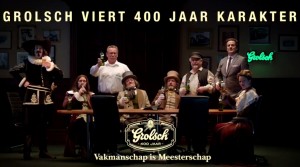 Next, the range of Dutch beers available in 1980 was narrower than ever: the brewers of The Netherlands only made a lot of pilsener lager, with some oud bruin and bock beer on the side (less than 1%). This means we have to look for the starting dates of those pilseners. And subsequently, a lot of beers can be dropped, because for instance Bavaria (from Lieshout) has made pils since only 1925.[1] So you can forget that year 1719 mentioned on their label, because what’s inside the bottle has only existed for less than a hundred years. For Grolsch, another brand that has a notorious fetish for advertising its year of origin, I couldn’t find a pilsener dating from before 1922. But then again, I still have to read their new book on ‘400 years of character’.[2] In any case: no Peter Kuijpers in the town of Groenlo in 1615 did not yet make Grolsch pilsener and he didn’t put it in swing-top bottles. (Update: the book ‘400 jaar karakter’ says absolutely *nothing* about when Grolsch started making pilsener. The name ‘Grolsch’ dates from 1913 anyway.)
Next, the range of Dutch beers available in 1980 was narrower than ever: the brewers of The Netherlands only made a lot of pilsener lager, with some oud bruin and bock beer on the side (less than 1%). This means we have to look for the starting dates of those pilseners. And subsequently, a lot of beers can be dropped, because for instance Bavaria (from Lieshout) has made pils since only 1925.[1] So you can forget that year 1719 mentioned on their label, because what’s inside the bottle has only existed for less than a hundred years. For Grolsch, another brand that has a notorious fetish for advertising its year of origin, I couldn’t find a pilsener dating from before 1922. But then again, I still have to read their new book on ‘400 years of character’.[2] In any case: no Peter Kuijpers in the town of Groenlo in 1615 did not yet make Grolsch pilsener and he didn’t put it in swing-top bottles. (Update: the book ‘400 jaar karakter’ says absolutely *nothing* about when Grolsch started making pilsener. The name ‘Grolsch’ dates from 1913 anyway.)
Now that we have scrapped those too from our list, we can also drop a number of brewers from the provinces of Brabant and Limburg that switched from top to bottom-fermenting in the years 1900-1930. This is true for Brand, Gulpener, Lindeboom, Alfa and Budels.[3] And forget about the trappist monks at Koningshoeven: their top-fermenting Trappist dated from 1958, was reworked into Enkel in 1993, of which in its turn production was ceased in 2000. Their current range of beers dates from after 1980.[4]
Which leaves us only a couple of Dutch beers whose origins lie in the nineteenth century. Amstel pilsener for instance has been around since 1882, but Heineken was just one year ahead of them. Their pilsener, now sold around the world, dates from 1881. And it was initially without their so often mentioned A yeast, because it was only developed by dr. Hartog Elion in 1886.[5] In any case, the first pilsener produced in Holland was that of the Amersfoortsche Beierschbier-Brouwerij, which appeared in 1879. After 1891 this company was continued under the name Phoenix, and believe it or not, but beer company United Dutch Breweries from Breda still has it made as an export beer.[6] As it happens, they also own Oranjeboom pils, which has quietly been brewed since 1887, with varying recipes. During the 1970s, it was an export only lager when in Holland itself it was sold under the name Skol. The same was true in the period 2004-2014, when InBev refused it access to the Dutch market.[7]
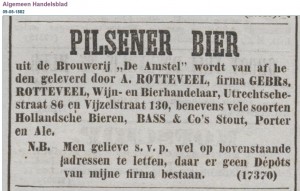 |
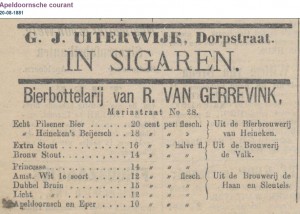 |
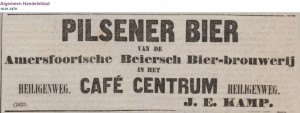 |
And yet, these pilseners are not Holland’s oldest beers. Their market share was initially quite modest anyway: in 1911 pilsener was only 12.7% of total production at Heineken’s Rotterdam plant.[8] For the oldest beer we need to look at other beer types. For instance, in 1880 the Amsterdam brewery De Gekroonde Valk (‘The crowned falcon’) released its Van Vollenhoven Stout. 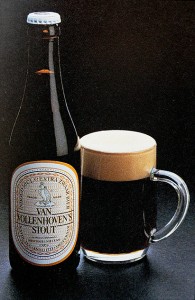 They were determined ‘to produce a Stout just as strong and healthy as its famous English counterpart, which is often recommended by physicians.’ To do so, they had built a new installation, with the help of an ‘experienced English brewer’.[9] This stout remained the brewery’s pride and joy, until the company was taken over by Heineken and closed in 1949. Heineken kept producing the stout until 2002, although it seems that by then it had become a bottom-fermenting beer. Late 2006 the Van Vollenhoven Stout was back, at the initiative of the gentlemen of the Gekroonde Valk Foundation, who had secured the original 1949 recipe out of the hands of the last brewer’s widow. And the Stout will be around for some while, because in the Spring of 2017 they will open their own brewery in Amsterdam. But I’ll get back to that later.[10]
They were determined ‘to produce a Stout just as strong and healthy as its famous English counterpart, which is often recommended by physicians.’ To do so, they had built a new installation, with the help of an ‘experienced English brewer’.[9] This stout remained the brewery’s pride and joy, until the company was taken over by Heineken and closed in 1949. Heineken kept producing the stout until 2002, although it seems that by then it had become a bottom-fermenting beer. Late 2006 the Van Vollenhoven Stout was back, at the initiative of the gentlemen of the Gekroonde Valk Foundation, who had secured the original 1949 recipe out of the hands of the last brewer’s widow. And the Stout will be around for some while, because in the Spring of 2017 they will open their own brewery in Amsterdam. But I’ll get back to that later.[10]
But even that stout is not the oldest beer. Interestingly, we have to look at that other Dutch bottom-fermenting beer style: bock. For one thing, Heineken released a bock beer in February 1874. In February, because at the time it was a typical spring beer (nowadays bock in Holland is an autumn and winter beer released every year around October).[11] However, in 1992 Heineken replaced its bock beer with a ‘Tarwebok’ (wheat bock), which means that, name and recipe being different, we cannot speak of the same beer anymore.[12]
No, the oldest Dutch beer still in existence is: Amstel Bock. It was advertised for the first time in April 1872.[13] Its production was halted during the First and Second World Wars, but the same goes for all pilseners. In the 1930s Amstel was one of the driving forces behind the ‘nationwide’ bock beer march in Amsterdam, with real goats and all (Dutch ‘bok’ means both ‘male goat’ and ‘bock beer’).[14] During the 1960s it was hardly advertised, but after Amstel was taken over by Heineken in 1968, the Amstel Bock label was restyled in 1972. That said, its production must have ceased for a few years, because it was relaunched in 1980, ‘because this beer type is enjoying increasing interest over the last few years.’ Probably that was also the moment that its ABV was raised from 6.5 to 7%. Anyway, after a short break the ‘deep red beer characterised by a strong, rich taste and beautiful head’ was back, in 1983 also on draught.[15]
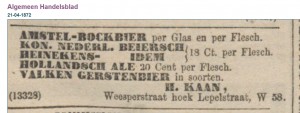 |
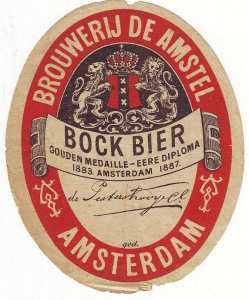 |
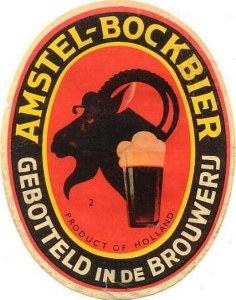 |
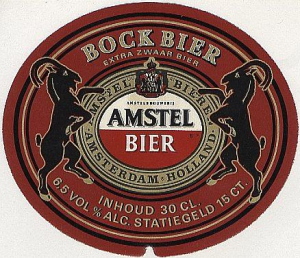 |
Amstel Bock is therefore, bar a few stops and starts, the oldest Dutch beer. And I like that, because it’s known as a surprisingly nice beer, surrounded by the Dutch bock beer tradition which is great fun. To quote beer historian extraordinaire Ron Pattinson, ‘Amstel Bock is proof that 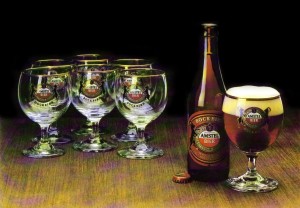 Heineken can brew a pretty good beer for a great price. When they can be arsed. Why don’t they do it more often?’[16] Holland’s oldest beer is, in short, a good bock beer, easily to come by for not too much money. It could have been worse.
Heineken can brew a pretty good beer for a great price. When they can be arsed. Why don’t they do it more often?’[16] Holland’s oldest beer is, in short, a good bock beer, easily to come by for not too much money. It could have been worse.
Finally, a honourable mention goes to Gulpener’s Mestreechs Aajt. This wonderful, much too sparingly available sour beer has been on the market since 1984, but was created after the original aajt as it was produced until the late 1950s. A gap of several decades is slightly too big to call it continuity, but it’s a great continuation of the old tradition, and there’s nothing made up about that.
[1] Antoon Swinkels and Peter Zwaal, Bavaria, biografie van een brouwerij en een familie uit Lieshout, Lieshout 2008, p.154.
[2] Tubantia 7-4-1922. On bieretiketten.nl there are no beer labels to be found from before the merger with the Enschedesche bierbrouwerij in 1922.
[3] Brand switched around 1900, G. Crutzen e.a., Traditie en vernieuwing, 125 jaar Brand, Wijlre 1996, p. 74-77; Gulpener and Lindeboom in 1913 (wikipedia and lindeboom.nl); Alfa around 1900 (wikipedia, biernet.nl); Dommels switched in ca. 1926, Myriam van Moolenbroek-Vogels, ‘Leven in de brouwerij’, in: Merckenswaert, jaarboek 1994 Heemkundekring ‘Weerderheem’ Valkenswaard, p. 46. Before the Second World War Budels was still very small and made only light and dark lager.
[4] Jef van den Steen, Trappist. Het bier en de monniken, Leuven 2003.
[5] Algemeen Handelsblad 9-5-1882; Apeldoornsche courant 20-8-1881; Keetie Sluyterman en Bram Bouwens, Heineken: 150 jaar. Brouwerij, merk en familie, Amsterdam 2014, p. 91.
[6] http://www.udbexport.com/en/merken/11-phoenix.html.
[7] Cf. http://lostbeers.com/princesse-beer-by-doranjeboom/. Production statistics of Oranjeboom pilsener and other beers: Oranjeboom Archives, City Archive of Rotterdam.
[8] barclayperkins.blogspot.nl/2015/02/lets-brew-wednesday-1911-heineken.html.
[9] Het nieuws van den dag 30-4-1880; De standaard 1-5-1880.
[10] See http://verlorenbieren.nl/verloren-bieren-15-van-vollenhovens-stout/. Cf. Het Parool, 20-11-2006. For the brewery that’s being built: http://www.vanvollenhovenbieren.amsterdam/.
[11] http://verlorenbieren.nl/verloren-bieren-8-het-verschuivende-bokbierseizoen/.
[12] Cf. De Telegraaf 8-10-1992.
[13] Algemeen Handelsblad 21-4-1872.
[14] Cf. De Tijd 18-11-1936.
[15] Vers van ‘t vat November 1972, p. 12-13; September 1980 p. 5; September 1983 p. 9.
[16] http://barclayperkins.blogspot.nl/2014/09/bokbier-season.html.
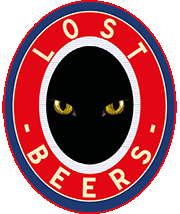





Leave a Reply